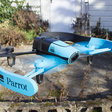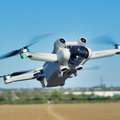(Pocket-lint) – The Parrot Bebop, which follows-up the company’s AR Drone 2.0, is an affordable high-flier with built-in 1080p camera and app-based controls via tablet or smartphone. At £430 it couldn’t exactly be called cheap, but in the world of drones it’s an affordable entry point that will come as a tempting prospect.
We’ve spent days playing with the Parrot Bebop in various environments and like the big kids that we are, have been getting excited about the prospect of spray-painting a giant yellow “H” onto our garden lawn.
Is the Bebop a successful mid-level product, or has it left us pining for more than its price point can offer?
The Parrot Bebop drone is a lot of fun. It’s easy to fly using the smartphone app and captures clear, smooth footage to its on-board storage with each flight.
However, battery life lasts for around 10-minutes per charge – fortunately there’s a spare battery in the box to double that – which isn’t as strong as some competitors, such as the DJI Phantom. Range-wise, for those who want to fly in terms of kilometres rather than a couple of hundred metres, you’ll want to shell out more money for the Skycontroller version. Which, at £770 paired the Bebop (it’s not sold separately – so think hard about this in advance), bumps this Parrot back into the realms of expensive.
Overall, for anyone who wants to dabble with a drone in their local vicinity, we think the Bebop is a fine example. It’s strong enough to take a beating from less experienced fliers, fun enough to keep you coming back for more, and versatile enough (in its Skycontroller version, anyway) to appeal to more pro-level users.

- Affordable
- Easy to use
- Robust
- Two batteries included
- Limited range
- Limited battery life
- Skycontroller version expensive
squirrel_133302
Design and build
The Bebop name sounds fun but it’s actually a pretty sleek looking high-flier. It comes in either black and blue, black and yellow or black and red. There are outer bumpers designed for indoor flying, but we found them helpful outside in confined garden space too – but gusts of wind can catch these and send the drone a bit out of control, so it’s best to remove them when doing any serious heights.
However, on first removing the Bebop from its packaging we thought it wasn’t the final product. It’s light to the point of feeling weak; part is made of a polystyrene material and there is a lot of movement in the joints. First impressions left us feeling worried we’d soon be sending it back in several pieces.
But we were wrong. The Bebop is lightweight, allowing it to hover with precision, but those moving joints and polystyrene upper make for perfect shock absorbers too. This, after a few crashes – and to be clear we crashed it from about 30 feet up after flying into a tree – left us feeling confident that the Bebop can take enough of a knock to enjoy flying it without worry.
Upon crashing the drone emits a noise and the power light flashes, which is a request for a restart. Tapping the power button twice and you’re good to go again.
The battery is the heaviest and largest part of the Bebop – that big black lump on the top. It slides out with a simple removal of the Velcro support and a pop of the connector. The whole battery can then be slid into the charger, which is provided in the box, and plugged right into the wall.
App-based controls
Interestingly the Parrot Bebop comes with no dedicated controller in the box. Instead you’ll need to download the FreeFlight 3 app – available for iOS, Android and Windows Phone – to take control. Although this helps keep the price point down, the Wi-Fi direct method of communication means range limitations.
A Skycontroller option is also available, complete with physical joystick controls, which offers a far greater range thanks to Wi-Fi radio with 4 antennas, but almost doubles the price point (£770, plus a tablet to run it, compared to £430 without). However, it adds a host of features, such as 2km range and even also allows you to connect virtual reality glasses, such as Oculus Rift, for a fully immersive 3D experience relayed back to your eyes. We did not review this particular setup, but it’s too cool to not give a mention. Check out the promo video below:
But let’s move back into the standard product. With the FreeFlight 3 app downloaded, all 1GB of it, our Android smartphone relayed the camera feed from the drone with little lag.
To set off on flight a simple tap of the “Take-off” green button sends the Bebop into launch, hovering at a height of about a metre. This button switches to become “Landing” while in flight, a touch of which lands the drone automatically and softly from any given height.
To the left side of the screen are height and spin rotation controls, which handle like a virtual joystick. On the right is the movement stick which needs to be held to activate then tipping the smartphone forwards or backwards, left or right, moves the drone around with reassuring precision. However, both are positioned so that your hands will cover portions of the screen when the bebop is in flight.
The same right-hand button that is held to fly can be double-tapped for tricks like flips or 180-degree rotations. Make sure you have plenty of height above before pulling off these moves as the Bebop automatically moves up before a trick and could hit the ceiling if you’re indoors. However, you’ll only get about three actions before the battery isn’t full enough to pull off such moves – and that despite these actions not cutting down the flight time by much.
The app does allow you to plot out route waypoints and the drone will fly these automatically. Plus there’s a “Return Home” button that uses the Bebop’s GPS to find its way back to you. The problem with both of these is that obstacles aren’t taken into account, so ensure you’re flying in a totally open area.
1080p video, 14MP stills
The Bebop’s built-in camera displays a clear image thanks to a fisheye lens with 180-degree field of view, supported by 3-axis digital image stabilisation technology. The 14-megapixel sensor might suggest Ultra-HD 4K capture, but the Bebop maxes out at Full HD (1920 x 1080 at 30fps), while still images can be snapped at the full resolution.
A two finger move on the screen moves the camera so you can check about before making a manoeuvre. Everything is recorded automatically to the drone’s 8GB on-board memory, with files transferrable to the connected device after landing. However, as you’d imagine, this takes ages and, given the 16GB on our particular smartphone, often wasn’t possible in full. Transferring to a PC via a cable is also an option – and the much more sensible one.
From the moment the Bebop takes flight it begins recording automatically, which is ideal for not missing a shot. However that 8GB memory gets used up fast so transferring regularly is required if you want to keep footage. Shame there’s no microSD card slot for expansion.
Facing into a light source can cause issues with flare, but we were impressed by how quickly the camera adapted exposure to keep results balanced throughout a flight.
Battery life, flight range and maintenance
Despite being its largest part, the Bebop’s battery lasts for around 10-minutes of real-world flight before needing a recharge. Luckily Parrot throws in two batteries so a quick swap has you up and running again swiftly. But don’t expect to keep going back-to-back as a full charge of the battery takes around an hour and a half.
The basic Bebop that we had was limited to the range of our smartphone’s Wi-Fi, meaning around 100-metres of real-world range without obstacles in the way in our experience. Parrot claims 300-metres, meaning location, other Wi-Fi signals, and the device being used for controls will likely have some impact on available range.
Should the Bebop fly out of range then it simply hovers waiting for the controller to be within range again. But it did once decide to automatically land, right in a road – not ideal.
In reality (without the pricey Skycontroller anyway) the range means use in the garden or around a field is absolutely fine. If you want to go a step beyond and go pro then to really take advantage you’ll need to shell out on the Skycontroller.
Lucky for us nothing broke in our time with the Bebop – despite some spectacular crashes – but Parrot does include spare rotor blades so you should be good to go even in a snapping situation. Other than keeping the Bebop charged and the lens clean there is nothing much else you really need to worry about.
READ: Parrot Swing drone review: Tiny, smart and lots of fun
squirrel_widget_133302
One of the best drones out there for near-pro level specs on an affordable, easy-to-use quadcopter – from beginner to pro this has you covered
Writing by Luke Edwards.
Source link

